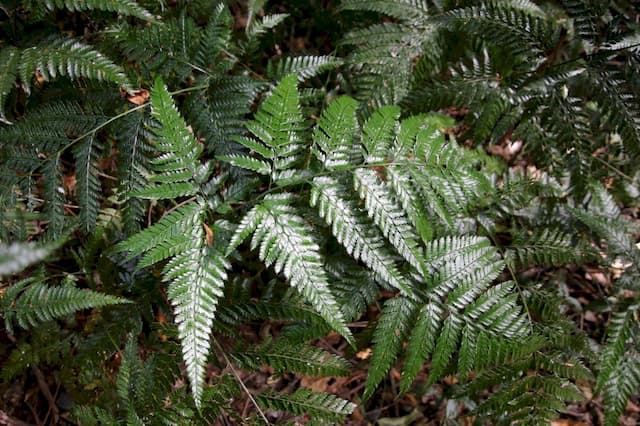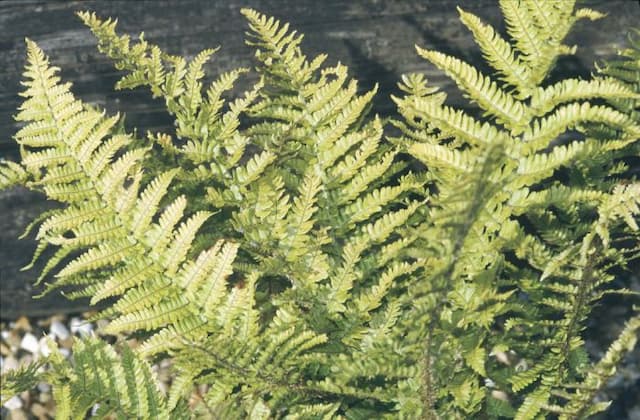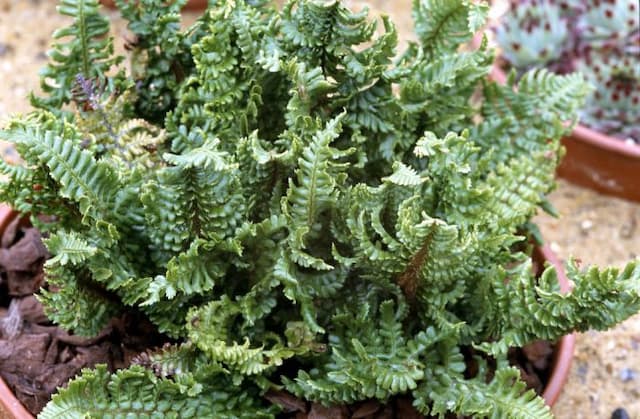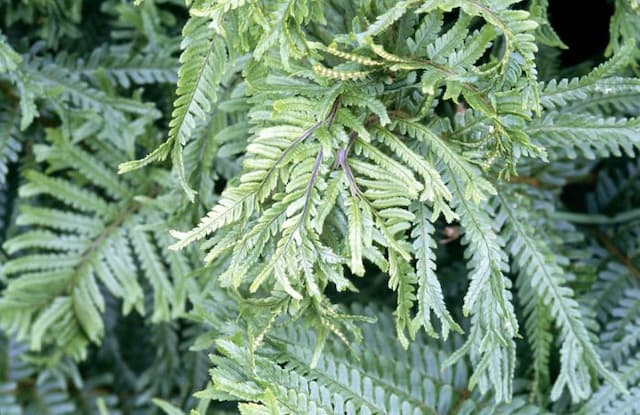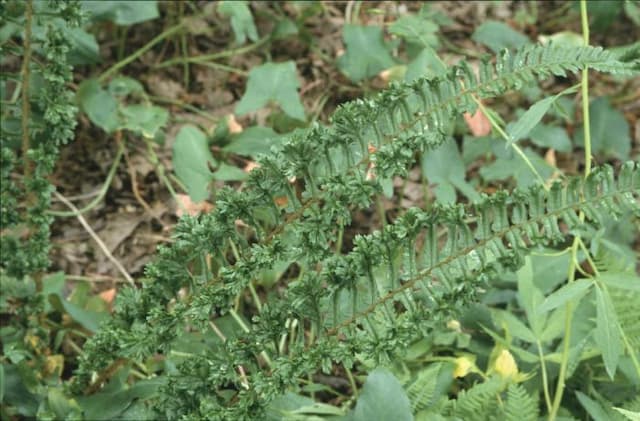Male fern 'Cristata' Dryopteris filix-mas 'Cristata'











ABOUT
'Cristata' is a deciduous fern making a rosette of erect or arching, almost bipinnate fronds to 60cm long, neatly crested at the apex and the tips of the pinnae
About this plant
 Names
NamesFamily
Dryopteridaceae.
Synonyms
Male Fern, Crested Male Fern, Crested Wood Fern, Crisped Buckler Fern, Crested Buckler Fern, King Fern, Crested Shield Fern.
Common names
Aspidium filix-mas 'Cristatum', Dryopteris filix-mas var. cristata, Nephrodium filix-mas var. cristatum, Polystichum filix-mas var. cristatum.
 Characteristics
CharacteristicsLife cycle
Perennials
Foliage type
Evergreen
Color of leaves
Green
Height
2-3 feet (0.6-0.9 meters)
Spread
2-3 feet (0.6-0.9 meters)
Plant type
Fern
Hardiness zones
4-8
Native area
Europe
Benefits
 General Benefits
General Benefits- Aesthetic Appeal: The Male Fern provides lush greenery and a natural aesthetic to gardens and woodlands with its crest-like fronds.
- Shade Tolerance: This fern thrives in shaded areas, making it ideal for underplanting beneath trees or in shady borders.
- Low Maintenance: Male Ferns require minimal care once established, with no need for pruning or deadheading.
- Soil Erosion Control: Their root system helps to stabilize soil and prevent erosion, especially on slopes or in moist, shady areas.
- Wildlife Habitat: Many species of wildlife, including birds and insects, find shelter among the fern's fronds.
- Seasonal Interest: Male Ferns provide year-round interest, with evergreen or semi-evergreen varieties maintaining foliage throughout the year in mild climates.
 Medical Properties
Medical Properties- Anthelmintic: The Male Fern, which is another name for Dryopteris filix-mas, has been used historically for its vermifuge properties to expel parasitic worms.
- Anti-inflammatory: It may have been used in traditional medicine for its anti-inflammatory effects.
 Air-purifying Qualities
Air-purifying QualitiesThis plant is not specifically known for air purifying qualities.
 Other Uses
Other Uses- As a natural dye: The leaves of the Male Fern can be used to produce a greenish-brown dye for textiles.
- In terrariums: Due to its attractive foliage, the Male Fern can be used to create miniature landscapes within glass containers.
- As a privacy screen: When planted densely, the Male Fern can act as a living privacy fence in shady garden areas.
- In floral arrangements: The fronds of the Male Fern can be included in floral displays for texture and greenery.
- As mulch: The dried fronds can be used as a natural mulch to help retain soil moisture and suppress weeds.
- In crafting: Dried fronds can be used in the creation of natural crafts, such as wreaths and wall hangings.
- For educational purposes: This plant can be used to teach botany and ecology, particularly concerning fern life cycles and reproduction.
- As a habitat for wildlife: The Male Fern can provide shelter and microhabitats for small insects and invertebrates.
- In themed gardens: The Male Fern can be used in fairy or woodland-themed gardens for its ethereal and lush appearance.
- For soil erosion control: The extensive root system of the Male Fern can help stabilize soil on slopes in shady, moist areas.
Interesting Facts
 Feng Shui
Feng ShuiThe Male Fern is not used in Feng Shui practice.
 Zodiac Sign Compitability
Zodiac Sign CompitabilityThe Male Fern is not used in astrology practice.
 Plant Symbolism
Plant Symbolism- Protection: Commonly known as Male Fern, the Dryopteris filix-mas 'Cristata' is associated with protection due to its hardy nature and ability to thrive in the wild.
- Secret Bond: The intricate frond pattern of the Male Fern can symbolize the complexity and depth of a hidden relationship or a secret bond between individuals.
- Discretion: With its preference for shade and understated elegance, the Male Fern often symbolizes discretion and the value of maintaining a low profile.
- Shelter: As ferns create microhabitats within forests and offer shelter to small wildlife, the Male Fern can represent refuge and the provision of shelter.
 Water
WaterThe Male Fern, commonly known as Male Fern, prefers consistent moisture without being waterlogged. Water the plant thoroughly once the top inch of soil feels dry to the touch, which may be about once a week, although this will vary depending on climate and indoor conditions. Use lukewarm water and aim for at least 16 ounces each time for potted ferns, making sure the water is evenly distributed across the potting mix. During the growing season in spring and summer, the plant may require more frequent watering, while in winter, the watering frequency should be reduced as the plant enters a dormancy period.
 Light
LightThe Male Fern thrives in partial to full shade, avoiding direct sunlight which can scorch its delicate fronds. A north-facing window or a spot that receives filtered light through a sheer curtain is ideal for this fern. Ensure it receives bright but indirect light for optimal growth, without exposing it to harsh afternoon sun.
 Temperature
TemperatureMale Fern grows best in temperatures between 60-70°F during the day and slightly cooler at night, around 50-60°F. It can withstand a minimum temperature of 30°F for short periods but is not frost-tolerant. The ideal indoor environment should avoid sudden temperature fluctuations and drafts.
 Pruning
PruningPruning the Male Fern consists mainly of removing dead or damaged fronds to maintain the plant's appearance and health. Prune in the spring before new growth begins for the best results. This task is usually required only once a year, or as needed, when you notice fronds that have yellowed or browned.
 Cleaning
CleaningAs needed
 Soil
SoilThe Male Fern's ideal soil mix is one that is rich in organic matter, such as leaf mold or compost, and well-draining. A mix of one-part garden soil, one-part peat or coconut coir, and one-part perlite or coarse sand works well. The soil pH should be slightly acidic to neutral, ranging from 5.5 to 7.0, to mimic its natural forest floor environment.
 Repotting
RepottingThe Male Fern should be repotted every two to three years to refresh the soil and provide space for growth. Best done in spring, repotting can also be an opportunity to divide the plant if it has grown too large.
 Humidity & Misting
Humidity & MistingThe Male Fern thrives in high humidity environments, ideally between 60% to 80%. To maintain these levels, especially indoors, a humidifier or regular misting of the foliage can be beneficial.
 Suitable locations
Suitable locationsIndoor
Provide bright, indirect light and high humidity.
Outdoor
Place in dappled shade, keep soil moist.
Hardiness zone
3-8 USDA
 Life cycle
Life cycleCristate Male Fern (Dryopteris filix-mas 'Cristata') begins its life cycle when spores, typically found on the underside of the fronds, mature and are released into the environment. These spores germinate in moist, shaded areas to produce a small, heart-shaped gametophyte (prothallus), which houses both male (antheridia) and female (archegonia) sex organs. With adequate moisture, fertilization occurs, leading to the development of a young fern known as a sporophyte, which will grow initially from the gametophyte. Over time, the mature sporophyte becomes an independent plant, developing the characteristic pinnate, crested fronds of the Cristate Male Fern. The fronds uncurl from a central crown in a fiddlehead or crozier fashion in spring, later reaching their full size and capable of photosynthesis. The plant continues this life cycle yearly, undergoing periods of growth in the spring and summer, followed by dormancy in the winter.
 Propogation
PropogationPropogation time
Spring-summer
The Male Fern 'Cristata', scientifically known as Dryopteris filix-mas 'Cristata', is most commonly propagated through division. The best time to carry out this process is in the spring, just before the new growth begins to emerge. To propagate by division, the plant clump should be carefully lifted from the ground and any soil clinging to the roots should be gently shaken off or washed away. The clump can then be divided using a sharp knife or spade into smaller sections, ensuring that each section has an adequate amount of roots and at least one growing crown. These divisions are then replanted at the same depth they were previously grown, spaced approximately 18 inches (about 45 centimeters) apart, to allow ample room for growth. Regular watering is necessary until the divisions become established. This simple division method is an effective way to increase the number of Male Fern 'Cristata' plants in your garden, allowing for a wider distribution of its distinctive and attractive fronds.
